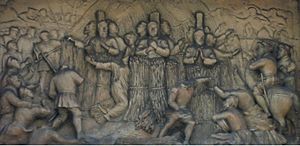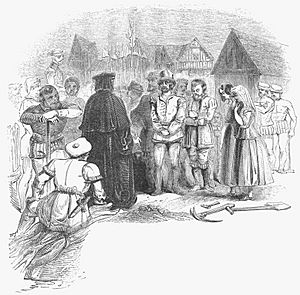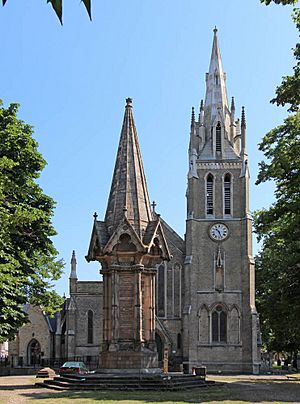Stratford Martyrs facts for kids
The Stratford Martyrs were a group of thirteen people – eleven men and two women – who were burned at the stake because of their Protestant beliefs. This sad event happened on June 27, 1556, near London, during a time known as the Marian persecutions. These persecutions were a period when Queen Mary I tried to bring England back to the Catholic Church, and people who held Protestant views were often punished.
Contents
Who Were the Stratford Martyrs?
A detailed story about these events can be found in a famous book by John Foxe called The Acts and Monuments. Foxe listed all the people who were executed that day.
The thirteen martyrs were:
- Henry Adlington, a woodcutter from East Grinstead
- Laurence Pernam, a blacksmith from Hoddesdon
- Henry Wye, a brewer from Stanford-le-Hope
- William Halliwel, a blacksmith from Waltham Holy Cross
- Thomas Bowyer, a weaver from Great Dunmow
- George Searles, a tailor from White Notley
- Edmund Hurst, a worker from Colchester
- Lyon Cawch, a merchant from Flanders who lived in the City of London
- Ralph Jackson, a servant from Chipping Ongar
- John Derifall, a worker from Rettendon
- John Routh, a worker from Wix
- Elizabeth Pepper from Colchester, who was pregnant
- Agnes George from West Bergholt
Three other men – Thomas Freeman, William Stannard, and William Adams – were also accused. However, they were allowed to go free by Cardinal Pole, who was the Archbishop of Canterbury, because they changed their minds and gave up their Protestant beliefs.
Why Were They Accused?
The sixteen people who were accused were brought to Newgate Prison in London from different parts of Essex and Hertfordshire. Starting on June 6, 1556, they faced a special church court. This court was led by Thomas Darbyshire, who worked for Edmund Bonner, the Bishop of London.
They were accused of nine different acts of heresy. Heresy means believing something different from the official teachings of the church. All of them either agreed with the charges or stayed silent. Because of this, they were all sentenced to death. Later, they wrote a letter explaining their beliefs. This letter was a response to a sermon (a religious speech) that had been given against them by John Feckenham, the Dean of St Paul's.
On June 27, 1556, the thirteen people who were still condemned were taken from London to Stratford. There, they were split into two groups and kept in separate rooms. The local sheriff tried to convince each group to change their minds and give up their beliefs. He even falsely told each group that the other group had already done so, hoping they would give in. But they did not.
The Execution
It is said that about 20,000 people came to watch the executions. The exact spot where they were executed is not known for sure. Most historians think it was at Fair Field in Bow, which was then known as Stratford-le-Bow. This area is north of where the Bow Church DLR station is today.
Another possible location is Stratford Green. Much of this area is now part of the University of East London Stratford Campus. This idea became popular after a memorial to the martyrs was put up in the nearby churchyard of the Parish Church of St John the Evangelist in 1879.
According to John Foxe, "eleven men were tied to three stakes, and the two women loose in the midst without any stake; and so they were all burnt in one fire."
Martyrs' Memorial
In 1879, a large monument was built in the St John's churchyard in Stratford Broadway. This memorial remembers the thirteen Stratford Martyrs and other people who were executed or tortured in Stratford during the persecutions. The memorial is a Grade II listed building, which means it is an important historical structure protected by the National Heritage List for England.
See also




